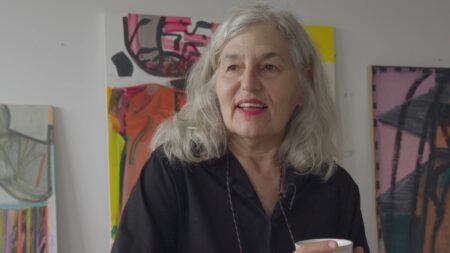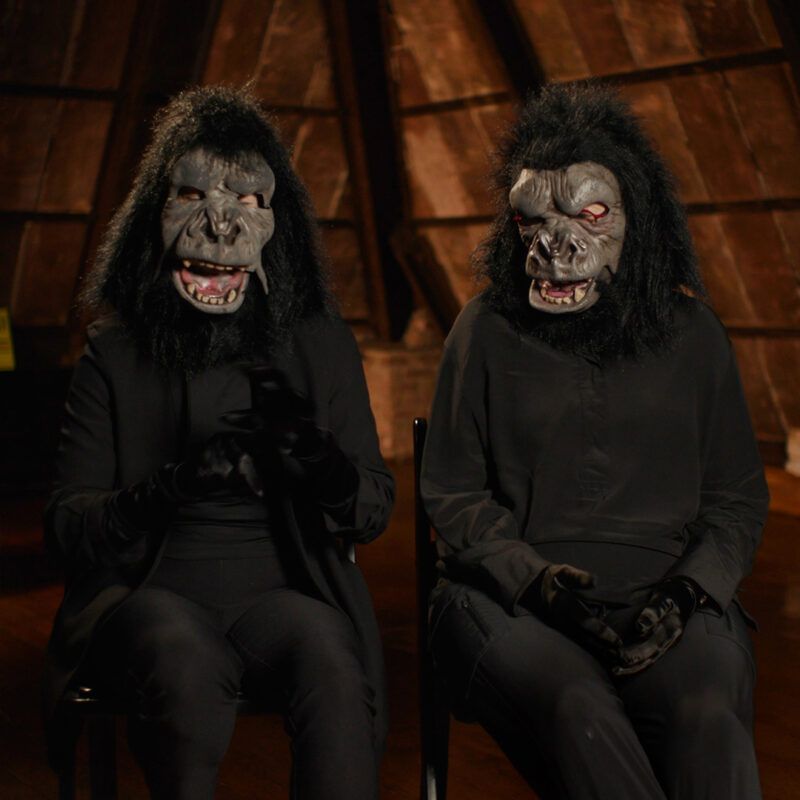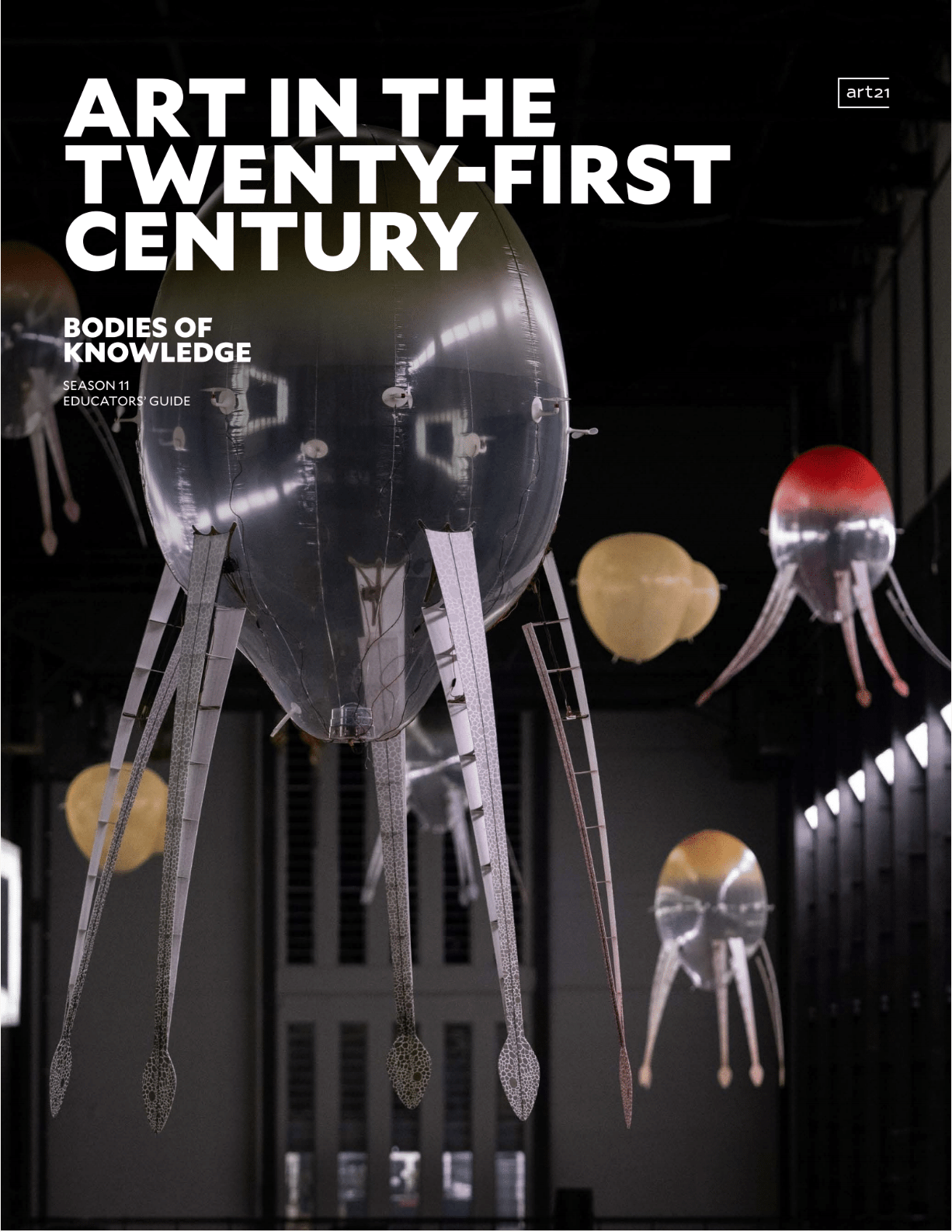Continue playing
(Time remaining: )
Play from beginning
Continue playing "{{ controller.videos[controller.getVideo(controller.currentVideo)].segmentParentTitle}}"
{{controller.videos[controller.getVideo(controller.currentVideo)].title}} has ended.
Guerrilla Girls in "Bodies of Knowledge"
Descriptive audio version available here.
Visit our Awards page for this film’s honors and recognition.
Clad in all-black, their faces obscured by oversized gorilla masks, “Frida Kahlo” and “Käthe Kollwitz” take to the streets as Guerrilla Girls to engage the public in their decades-long battle against discrimination in the art world. “Kahlo” and “Kollwitz,” pseudonyms adopted by the artists while acting as Guerrilla Girls, have been members of the artist-activist collective since its founding in 1985. Tracing the story of Guerilla Girls through nearly four decades of art and activism, this film explores the continued relevance and impact of their fight for equality.
Responding to the exclusion of women artists and artists of color from the art world and its institutions, Guerrilla Girls came together in search of new ways to call attention to discrimination. The collective began making posters with salacious headlines and bold designs, pasting them to buildings and gallery windows in New York City’s East Village and SoHo neighborhoods. On these posters, the collective shared publicly accessible statistics that served as irrefutable evidence that gallerists, critics, artists, and museums participated in the exclusion of women and people of color. These spectacular critical gestures have solidified Guerrilla Girls’ reputation as a force to be reckoned with among art world stakeholders. As their work became a sign of hope for many artists and art professionals, it also became a source of anxiety for the individuals and institutions they called attention to.
In 1989, Guerrilla Girls created a code of ethics they believe should be installed outside every art museum — their Guerrilla Girls’ Code of Ethics for Art Museums. Initially conceived of as a poster with ten commandments for art museums that satirize the systemic inequalities perpetuated by arts institutions, in 2022 Guerrilla Girls’ dictates now appear ‘etched in stone’ on an imitation stele. Wheeling their new monument in front of the Solomon R. Guggenheim Museum, the Museum of Modern Art, and the Whitney Museum of American Art, “Kahlo” and “Kollwitz” use the code of ethics as a conversation starter, engaging museum-goers and passersby in a dialogue about how we could improve museums. “Can’t we think about art as not being about winners,” says “Kahlo,” “but about being something we all need in our lives?” Reaching audiences locally and internationally, Guerrilla Girls’ push for equality has inspired generations of artists and activists to join them in pursuing a kinder, more collective vision of what art can be.
More information and creditsCredits
Executive Producer: Tina Kukielski. Series Producer: Nick Ravich. Director: Malika Zouhali-Worrall. Producer: Danielle Varga. Editor: Steven J. Golliday. Director of Photography: Naiti Gámez. Assistant Curator: Jurrell Lewis. Associate Producer: Andrea Chung. Design & Animation: Ryan Carl, Nikita Iziev. Composer: Andrew Orkin.
Additional Photography: Julia Liu, Jenni Morello, Mattia Ramberti, Brianna Wray. Assistant Camera: George Alvarez, Javier Castillo, Allen Dobbins, Sarah Jaffe, Todd Leatherman. Location Sound: Jim Choi, La’Ron Cooper, Damon Karys, Alberto Ladduca, Lily van Leeuwen, Taylor Roy, Emily Strong, Tommaso Zerbini. Field Producer: Ursula Liang. Production Coordinators: Sasha Leitmann, Arjun Pothuri. Production Assistants: Connor Finn, Kabir Kumar-Hardy, Quan Robinson, Gordon Taylor, Mishel Valle-Ayala. Art Handlers: Robert Guynn, Chris Rogy.
Advising Proder: Ian Forster. Video Post-Production Services: Cut + Measure. Video Post-Production Producer: Alex Laviola. Colorist: Chris Ramey. Online & Conform: David Gauff. Additional Video Editor: Addison Post. Post-Production Coordinator: Leah Ford. Additional Animation: Andy Cahill, Yasmin Mistry. Audio Post-Production Sound Services: Konsonant Post. Re-Recording Mixers: Gisela Fullà-Silvestre, Ben Kruse. Sound Editor: Ben Kruse. Assistant Editors: Ellen Askey, Stephanie Cen, Michelle Hanks. Station Relations De Shields Associates. Legal Counsel: Withersworldwide. Additional Curatorial Research: Susan Thompson.
Additional Art21 Staff: Lauren Barnett, Hannah DeGarmo, Lolita Fierro, Joe Fusaro, Molaundo Jones, Emma Nordin, Anna Pruett, Jessica Svenson, Noor Tamari, Nora Wimmer. Interns: Stephanie Ades, Sekou Cherif, Yeon Cho, Michaela Esteban, Emma Flood, Amber He, Carina Martinez, Renee Rienecker, James Santiago, Adam Varca, Dani Wieder.
Artwork Courtesy: Tauba Auerbach, Guerrilla Girls, Hank Willis Thomas, Anicka Yi, Paula Cooper Gallery, Jack Shainman Gallery, Gladstone Gallery, Anicka Yi, “Metaspore” at Pirelli HangarBicocca, Milan, 2022.
Archival Materials: Kelvin Adjei-Akosah, Agence France-Presse, Associated Press
Bettmann, Lance Brewer, David Briddell, Ron Cogswell, David M. Rubenstein Rare Book & Manuscript Library, Duke University; Embrace Boston, Equal Justice Initiative , Estate of Ernest Cole, Getty Images, Great Voices of Bulgaria, The Guardian, Amy Harrison, Human Pictures, Hulton Archive, Library of Congress, Magnum Photos, MASS Design Group, The New Press, Steven Probert, Public Art Fund, SandenWolff, San Francisco Museum of Modern Art, Jon Santos, Katja Schulz, Davina Semo, Ted Shaffrey, Skyhorse Publishing, Clarissa Sligh, Damon Styer, Tate Modern, Temple University Press, Time Inc, TV1 Broadcast Company, Bulgaria; Richard Vogel, W. W. Norton & Company.
Interviewees: Cleo Berliner, Esther Chao, Jonathan Evans, Coco Fusco, Sam Giarratani, Jasmine Guzman, Rujeko Hockley, Emily Majors, Muna Malik, Cameron Mesirow, Roberto Morales, Frances Morris, Sriranjini Raman, Samhita Ramji, Juan Rojero, Will Sylvester, Jawaid Toppa, Dr. Deborah Willis.
Special Thanks: The Art21 Board of Trustees, Xabier Arakistain, John Felix Arnold, Art Gallery of Ontario, Joseph Becker, Bert Bergen, Olivia Berke, Alessandro Bianchi, Sanford Biggers, The Boston Foundation, Alessandro Cane, Christina Caputo, Yu Rim Chung, Collection of the City of Boston, Allison Cooper, Christian Dioulo, Folasade Falebita, Jenny Gheith, Goodman Gallery, South Africa, Andy Greenberg, Remina Greenfield, Fiammetta Griccioli, Clara Hatcher Baruth, Imari Jeffries, Thomas Kelley, Rob Massey, Stacee Prigmore Monroe, National Memorial for Peace and Justice, A. Joaquin Navas, Negative Space, Devan Owens, Fernando Ramirez, Erik Savercool, Melissa Shakun, Hana Tran, Saulius Valaitis, Walla Walla Foundry, The Wave Organ, Maria Wiles, Family of Hank Willis Thomas.
Major underwriting for Season 11 of Art in the Twenty-First Century is provided by PBS, National Endowment for the Arts, Lambent Foundation, The Anna-Maria and Stephen Kellen Foundation, The Andy Warhol Foundation for the Visual Arts, The Horace W. Goldsmith Foundation, Toby Devan Lewis, Robert Lehman Foundation, and Nion McEvoy & Leslie Berriman.
Series Creators: Susan Dowling and Susan Sollins.
©2023 Art21, Inc.
Closed captionsAvailable in English, German, Romanian, Italian, Japanese, Korean, Chinese, Italian
Through the Art21 Translation Project, multilingual audiences from around the globe can contribute translations, making Art21 films more accessible worldwide. Translate this video now.
Interested in showing this film in an exhibition or public screening? To license this video please visit Licensing & Reproduction.
Guerrilla Girls are an anonymous collective of women artist-activists who began working together in 1985. Working across various media, the collective challenges the systems and individuals perpetuating discrimination and inequality in the art world by publicly sharing data and statistics about the representation of women and artists of color in commercial and institutional art spaces. Embracing the disruptive, confrontational, and irreverent, Guerrilla Girls draw from street art and the legacies of feminist activism to launch their critique of the art world.
“There’s nothing worse than the word ‘art appreciation.’ It implies that you’re just there awestruck, and whatever you’re being fed, you appreciate. Art really is about discourse and about discussion.”
“Frida Kahlo,” Guerrilla Girl





